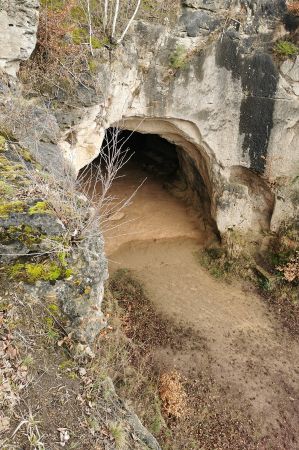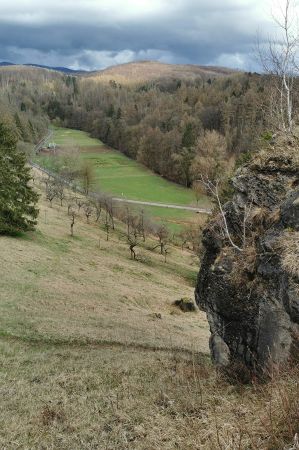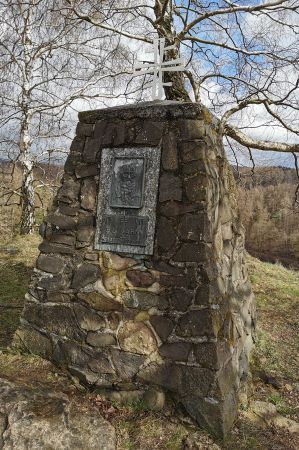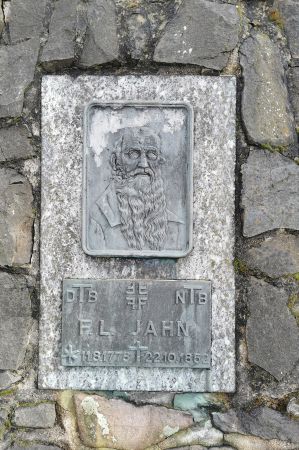Hike to the cave church in the Dolomite rocks at Scharzfeld
- Written by Portal Editor
We had often passed the eye-catching dolomite rocks near Scharzfeld on our way through the Harz Mountains, and now there was finally enough time for a short hike up the rocks and on to the legendary "Unicorn Cave".
As always, the hiking boots were there, the backpack with rain gear and some provisions anyway, so nothing stood in the way of the ascent.
Archaeological finds indicate ancient use
 The cave and the dolomite rocks are located in the nature reserve between Herzberg am Harz and Bad Lauterberg, just north of Scharzfeld on the southern slope of the Steinberg within the Harz Nature Park, which means that the southern tip of this mountain ridge made of dolomite rock is also protected. These rocks are characterized by a steep slope with many cliffs, which is why they caught our eye.
The cave and the dolomite rocks are located in the nature reserve between Herzberg am Harz and Bad Lauterberg, just north of Scharzfeld on the southern slope of the Steinberg within the Harz Nature Park, which means that the southern tip of this mountain ridge made of dolomite rock is also protected. These rocks are characterized by a steep slope with many cliffs, which is why they caught our eye.
Arriving at the top of the rock we should be unexpectedly surprised by a monument, because there was a former "stone church" in the cave in the rocks, which is opened up for tourism with an access road from the opposite side. The cave is located on the south-southwest slope of the Steinberg at about 341 m above sea level, between the Bremke valley in the east and the Mönchetal.
 The round-arched cave itself is about 28 m long, 6 to 8 m high and just as wide. In the Palaeolithic Age, the cave is said to have served as a storage place for reindeer hunters.
The round-arched cave itself is about 28 m long, 6 to 8 m high and just as wide. In the Palaeolithic Age, the cave is said to have served as a storage place for reindeer hunters.
A longer-lasting archaeological excavation of the cave floor and the outer forecourt took place in the years 1925 to 1928. Paleolithic finds from the period between 15,000 and 8,000 BC were unearthed. salvaged. During the excavation, this was the oldest archaeological material that had been discovered in Lower Saxony up to that point. The finds included flint knives, a bone needle and various animal bones. Based on comparable finds in France, the finds could be attributed quite clearly to the presence of reindeer hunters in a late Ice Age environment. Even after that, groups of hunters used the place for short stays, such as Mesolithic forest hunters around 5,000 BC. and humans during the pre-Roman Iron Age around 500 BC. Chr.
Use of the cave as a church with a cemetery
 From the 9th century, the cave served as a church room with a cemetery in front, which was probably forgotten from the 16th century. A pulpit carved into the rock at the entrance bears witness to this.
From the 9th century, the cave served as a church room with a cemetery in front, which was probably forgotten from the 16th century. A pulpit carved into the rock at the entrance bears witness to this.
A niche was also carved out of the stone to house an altar. The cave entrance was then closed with a porch.
This is indicated by the found foundation and roof tile remains. From the Middle Ages to the 16th century, around 100 burials took place in the ground on the forecourt in front of the cave.
The period could be determined on the basis of coin finds. The dead were mostly buried in wooden coffins. In contrast to this, only one grave site was a pure stone grave that had been carved into the stone underground. It lay just in front of the pulpit of the stone church and contained the skeleton of a woman.
 Almost as a matter of course, a number of sagas and legends are entwined around the stone church and the cave. The missionary Bonifatius is said to have knocked the cave out of the rock with a wooden hammer in the 8th century. He then baptized heathens in the nearby Harz River Oder.
Almost as a matter of course, a number of sagas and legends are entwined around the stone church and the cave. The missionary Bonifatius is said to have knocked the cave out of the rock with a wooden hammer in the 8th century. He then baptized heathens in the nearby Harz River Oder.
Another legend brings a unicorn into play as a mythical animal, after which the unicorn cave near Scharzfeld is named.
In pagan times, an old and wise woman lived in the cave-like stone church, who probably worked as a fortune teller to help those seeking advice. One day she chased away a monk in a black robe accompanied by Frankish warriors. A unicorn is said to have protected her from her pursuers. The woman joined the witch community. After that, the black monk disappeared into a hole in the ground, which led to the discovery of the unicorn cave. Which brings us to our next hiking destination.
From the cave church to the unicorn cave
 Numerous hiking routes run through the nature reserve, including the Karstwanderweg Südharz. However, we follow the signs to the unicorn cave on the ridge.
Numerous hiking routes run through the nature reserve, including the Karstwanderweg Südharz. However, we follow the signs to the unicorn cave on the ridge.
In the southern area, species-rich calcareous grassland can be found on the ridges and slopes, as well as crevice vegetation in the cliff areas.
The areas of nutrient-poor grassland that have emerged from extensive use are extensively grazed with goats to maintain them and to avoid encroachment.
In the northern area of the nature reserve there is mixed forest, which is used for forestry purposes with the aim of converting it into a deciduous beech forest.
 Unfortunately, at some point the signage ends, so we have to switch to satellite navigation, where we come across forest paths that are so rutted that they can hardly be walked. Only on the way back do we realize that a fork had taken us on the wrong path, which then led through bushes and fallen trees. So we were happy to have arrived at the unicorn cave after about 2 hours.
Unfortunately, at some point the signage ends, so we have to switch to satellite navigation, where we come across forest paths that are so rutted that they can hardly be walked. Only on the way back do we realize that a fork had taken us on the wrong path, which then led through bushes and fallen trees. So we were happy to have arrived at the unicorn cave after about 2 hours.
Unfortunately, the time had advanced so far that a further tour through the cave was no longer possible. Since both the hiking restaurant and the unicorn cave seemed quite interesting, we had already decided on site to repeat the visit. Then it should go by bike from Clausthal-Zellerfeld to the unicorn cave. We will report!
Please also read:
Let's go downtown Warsaw – by Public Transport
Omis - adrenaline fun in a spectacular canyon landscape
-
 Hiking to Steinkirche in Scharzfeld
Hiking to Steinkirche in Scharzfeld
Hiking to Steinkirche in Scharzfeld
Hiking to Steinkirche in Scharzfeld
-
 Hiking to Steinkirche in Scharzfeld
Hiking to Steinkirche in Scharzfeld
Hiking to Steinkirche in Scharzfeld
Hiking to Steinkirche in Scharzfeld
-
 Hiking to Steinkirche in Scharzfeld
Hiking to Steinkirche in Scharzfeld
Hiking to Steinkirche in Scharzfeld
Hiking to Steinkirche in Scharzfeld
-
 Hiking to Steinkirche in Scharzfeld
Hiking to Steinkirche in Scharzfeld
Hiking to Steinkirche in Scharzfeld
Hiking to Steinkirche in Scharzfeld
-
 Hiking to Steinkirche in Scharzfeld
Hiking to Steinkirche in Scharzfeld
Hiking to Steinkirche in Scharzfeld
Hiking to Steinkirche in Scharzfeld
-
 Hiking to Steinkirche in Scharzfeld
Hiking to Steinkirche in Scharzfeld
Hiking to Steinkirche in Scharzfeld
Hiking to Steinkirche in Scharzfeld
-
 Hiking to Steinkirche in Scharzfeld
Hiking to Steinkirche in Scharzfeld
Hiking to Steinkirche in Scharzfeld
Hiking to Steinkirche in Scharzfeld
-
 Hiking to Steinkirche in Scharzfeld
Hiking to Steinkirche in Scharzfeld
Hiking to Steinkirche in Scharzfeld
Hiking to Steinkirche in Scharzfeld
-
 Hiking to Steinkirche in Scharzfeld
Hiking to Steinkirche in Scharzfeld
Hiking to Steinkirche in Scharzfeld
Hiking to Steinkirche in Scharzfeld
-
 Hiking to Steinkirche in Scharzfeld
Hiking to Steinkirche in Scharzfeld
Hiking to Steinkirche in Scharzfeld
Hiking to Steinkirche in Scharzfeld
-
 Hiking to Steinkirche in Scharzfeld
Hiking to Steinkirche in Scharzfeld
Hiking to Steinkirche in Scharzfeld
Hiking to Steinkirche in Scharzfeld
-
 Hiking to Steinkirche in Scharzfeld
Hiking to Steinkirche in Scharzfeld
Hiking to Steinkirche in Scharzfeld
Hiking to Steinkirche in Scharzfeld
-
 Hiking to Steinkirche in Scharzfeld
Hiking to Steinkirche in Scharzfeld
Hiking to Steinkirche in Scharzfeld
Hiking to Steinkirche in Scharzfeld
-
 Hiking to Steinkirche in Scharzfeld
Hiking to Steinkirche in Scharzfeld
Hiking to Steinkirche in Scharzfeld
Hiking to Steinkirche in Scharzfeld
-
 Hiking to Steinkirche in Scharzfeld
Hiking to Steinkirche in Scharzfeld
Hiking to Steinkirche in Scharzfeld
Hiking to Steinkirche in Scharzfeld
-
 Hiking to Steinkirche in Scharzfeld
Hiking to Steinkirche in Scharzfeld
Hiking to Steinkirche in Scharzfeld
Hiking to Steinkirche in Scharzfeld
-
 Hiking to Steinkirche in Scharzfeld
Hiking to Steinkirche in Scharzfeld
Hiking to Steinkirche in Scharzfeld
Hiking to Steinkirche in Scharzfeld
-
 Hiking to Steinkirche in Scharzfeld
Hiking to Steinkirche in Scharzfeld
Hiking to Steinkirche in Scharzfeld
Hiking to Steinkirche in Scharzfeld
-
 Hiking to Steinkirche in Scharzfeld
Hiking to Steinkirche in Scharzfeld
Hiking to Steinkirche in Scharzfeld
Hiking to Steinkirche in Scharzfeld
-
 Hiking to Steinkirche in Scharzfeld
Hiking to Steinkirche in Scharzfeld
Hiking to Steinkirche in Scharzfeld
Hiking to Steinkirche in Scharzfeld
-
 Hiking to Steinkirche in Scharzfeld
Hiking to Steinkirche in Scharzfeld
Hiking to Steinkirche in Scharzfeld
Hiking to Steinkirche in Scharzfeld
https://www.alaturka.info/en/hiking-tours/6104-hike-to-the-cave-church-in-the-dolomite-rocks-near-scharzfeld#sigProIdc44dac68e7

